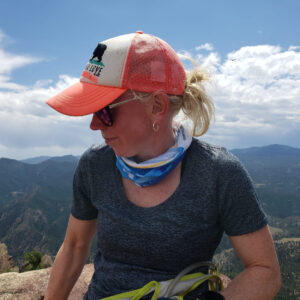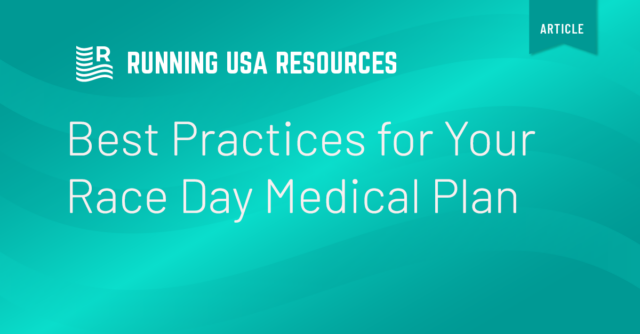by Kelly O’Mara
The thing about medical emergencies is they’re emergencies, which means they can happen anytime and when they do you have to be prepared to respond quickly. And putting on a race means that you know that there are going to be a certain amount of medical emergencies and non-emergencies: minor, moderate, and serious.
Dr. William Roberts, medical director for the Twin Cities Marathon, once called a major marathon a “planned disaster,” by which he means that there is going to be planned overload on the medical staff and it’s simply a question of preparing adequately for the surge. Even small and medium-sized races need to have a plan in place both for the mild medical issues that will likely arise and for the serious ones that could happen.
“Part of the reason we’re there is so they don’t all end up in the ER,” said Roberts, so that you don’t overrun the local medical system.
Many permits for a race will require a medical plan for just this reason.
Staff your medical resources
Most importantly, even small and medium-sized races need to invest in medical staff and resources, said both Roberts and Chris Troyanos, ATC, long-time medical coordinator for the Boston Marathon. You can’t take for granted that nothing serious will happen just because your race is shorter or smaller.
Will you hire EMS or rely on volunteer medical staff? It can be challenging right now to find physicians who want to work events and take on that liability, said Troyanos. You need to have someone who at least knows CPR and can use an AED, said Roberts. You also shouldn’t be putting the race director in the position to make medicals diagnoses of athletes; you should have some kind of medical director to develop a medical plan. And even if you rely on volunteer medical staff, you’ll likely need to have EMT or paramedics on standby.
When someone hires him to run their medical services, said Troyanos, the first thing he does is reach out to the fire and the police departments, and then talks with the local hospitals so they’re aware. “You have to have some level of coordination,” he said.
The medical plan will then start by figuring out the approximate surge capacity (ie. the largest amount of medical issues you’ll likely have to deal with). A rule of thumb is the peak amount will be 1-2% of field size, though that can be more when the race is longer or hotter. What is considered hot also depends on the seasonal weather—what athletes in the area are accustomed to and how prepared they are (ie. if you have more beginners or more elite athletes, if the race is in Florida or Minnesota). A rough staffing estimation, said Roberts, is up to two medical staff for a 5K, 2-4 staff for a 10K, and 5-10 staff for a half-marathon or longer, for up to every 1,000 athletes—taking into account, of course, weather and conditions.
Prepare for the most common emergencies
Once you have your race medical staff, you need to decide what kind of medical services you will provide on site, said Roberts. Will you be basic first aid or higher level medical care? Again, that depends on weather, history, field size, and athlete demographics. If you’re going to provide things like IVs and ice baths, then that’s a higher level medical tent.
No matter what, you should prepare for the most common medical issues. While most visits to race-day medical are often musculoskeletal—chaffing, blisters, sprains, strains, abrasions and cuts—there are a few serious common issues all races should know about:
– exercise associated collapse
– exertion heat stroke
– exercise associated hypoglycemia
– anaphylaxis
– cardiac arrest
Read more about the most common medical issues and how to recognize them.
To deal with these common medical issues, Roberts said even small events should have, at a minimum: an automated external defibrillator (AED), quick epinephrine in case of an allergic reaction, some kind of glucose for diabetics, and at least a basic plan for a way to cool people down. Serious heat stroke can be very intensive to treat, typically involving either ice water tubs (which require a hose hookup), rotating cold ice water towels replaced as they warm up, or a “six-pack of ice” system putting bags of ice in the neck, groins, and armpits.
However, if you want to fully diagnose and treat heat stroke, you also need to take a rectal temperature. And if you want to treat hypoglycemia, you really should have the ability to check sodium levels. “If you don’t have the capacity to check sodium on site, then no reason to have IV/saline,” said Roberts. Taking in salty broth orally is often as good as IV if the athlete isn’t throwing up.
Create a communication & access plan
“I can’t prevent the cardiac arrest, but I can make sure I can respond to it as quickly as hell,” said Troyanos. Cardiac arrest in a race is relatively rare, but when it does happen it’s the most serious medical issue and survival depends on how quickly someone is able to get to the athlete and use an AED (and have emergency ambulance services transport them).
To prepare your medical plan, answer two questions, said Troyanos: How will you respond quickly? How will your medical staff communicate?
In addition to finish line medical tents, you should also have medical staff out on course. Troyanos and Roberts said they’ve both relied more on mobile medical staff in recent races, which allows staff with AEDs to be riding around on bikes with radios and communication tools—and can then respond quickly. The key, however, is having a communication plan in place: either using spotters on course (at multiple points so that if two spotters call in then the responding medical services know the athlete is in between those two points) or using a radio or app system, so that when a call comes in the closest person is immediately dispatched to the incident and 9-1-1 is called first if needed—for example, in the case of a cardiac arrest. Roberts said they’ve also started using a Race Safe app, which allows medical staff to input an athlete’s bib number and get their medical info, track their location, and follow their diagnosis and outtake.
Once you have a staffing plan, a plan for responding to common medical issues, and a communication plan, design your medical area:
– Look at your course and figure out how ambulances or emergency crew will access athletes. Where will medical responders be stationed? Will they be mobile throughout the course or at certain spots? How will they communicate?
– Put medical services upstream from the finish, stationing someone about 500-600 yards before the line. It’s “fairly common,” said Troyanos, to have cardiac and other issues at that point. It also allows medical to spot and prepare for athletes.
– At the finish line, use spotters to identify athletes who might need help. If someone is looking unsteady, then have a conversation with them to check their mental state, said Troyanos. Direct people who need help to the medical tent or medical area.
– The med tent should be about 40-50 yards from the finish line. At larger races (or races that will require more medical needs because of the heat, length, or extremity of the event), you may need to staff the finish area with people to help transport athletes and intake athletes. Best practices dictate large medical tests should operate using a triage and intake system—much like a mobile ER.
– And then don’t forget about the post-finish. In larger races, again, you’ll want to have some spotters or staff in the post-finish or food area to spot any athletes who might be having issues. It’s not uncommon for their to be the occasional serious medical reaction well after the finish line—and have a plan on how to get to those athletes, because the density of people at that point can make quick access challenging.
About the Author
 Kelly O’Mara is the former editor-in-chief of Triathlete Magazine and the founder of the Triathlonish
Kelly O’Mara is the former editor-in-chief of Triathlete Magazine and the founder of the Triathlonish

